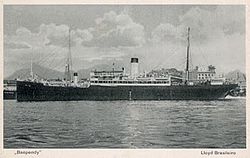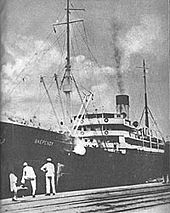Baependy (ship)
|
||||||||||||||||||||||
|
||||||||||||||||||||||
|
||||||||||||||||||||||
|
||||||||||||||||||||||
The Baependy was a steamship put into service in 1899 , which originally belonged to Hamburg Süd and from 1925 to the Brazilian shipping company Companhia de Navegação Lloyd Brasileiro , in whose service it transported passengers and freight for 19 years. She was one of five Brazilian merchant ships that were sunk in mid-August 1942 within 48 hours of the German submarine U 507 without warning off the Brazilian coast.
A total of 607 people died, 270 of them on the Baependy . As a result of this event, Brazil declared war on the German Reich on August 22, 1942.
The ship
The 4,801-ton steamer was in 1899 Hamburg-Steinwerder from the shipyard Blohm & Voss for the German shipping company Hamburg Süd (HSDG) as the last ship of the eleven units comprehensive Asuncion built class and ran on 5 July 1899 under the name Tijuca launched . The ships of the class, which Hamburg-Süd had procured since 1895, handled the shipping company's passenger and emigrant traffic to South America.
On August 23, 1899, the Tijuca started on her maiden voyage from Hamburg to Santos . The ship was 114.5 meters long, 14.1 meters wide and had a maximum draft of 8.38 meters. The Tijuca was propelled and drove at an average cruising speed of 11.5 knots. The quadruple expansion steam engine achieved an output of 2,000 PSi. In the first class, 50 passengers could travel, in the intermediate deck there was space for 400 more people.
The Cap class steamers acquired in 1900 replaced the Tijuca and her sisters as top ships in passenger service on the main HSDG line, on which even high-speed steamers were used from 1911 with the Cap Finisterre and then the Cap Trafalgar , so that the use of the passenger facilities of the older Asuncion- class ships declined and they were mainly used as cargo or emigrant ships.
In August 1914, the steamer was interned in Recife . On June 1, 1917, the Tijuca was confiscated by the Brazilian government along with 44 other German ships in Brazilian ports. The ship was renamed Baependy and, like other ships confiscated from Brazil, was made available to France for a time.
In 1923 the Companhia de Navegação Lloyd Brasileiro took over the management of the ship and acquired it in 1925. The Lloyd Brasileiro was a state shipping company that had existed since 1894 and was based in Rio de Janeiro , which operated passenger and freight traffic in Brazilian coastal waters and the Amazon basin . In the twenties, she received almost all confiscated German ships and built a network of routes to the USA and Europe. The sister ships Asuncion , San Nicolas and Santos of the Baependy were among the more than 40 ships taken over by various German shipping companies . In the service of Lloyd Brasileiro these four ships were used as passenger and cargo ships along the Brazilian coast and up the Amazon.
Sinking
In mid-August 1942, the Baependy was on another passage from Rio de Janeiro to Salvador da Bahia , Maceió , Recife and Manaus in the state of Amazonas . There were 73 crew members and 233 passengers on board, a total of 306 people. Among the passengers were 142 members of the 7th Artillery Regiment stationed in Recife. The remaining passengers were civilians, including many family members of the soldiers. Captain João Soares Da Silva was in command.
On August 15, around 7:00 a.m., the ship left Salvador da Bahia. The next stop should be Maceió, about 250 miles north in the state of Alagoas . On the following day, Sunday, August 16, the Baependy was sighted by U 507 . U 507 was a German submarine of the type IX C , which was under the command of Korvettenkapitän Harro Schacht on patrol .
The ship was about 20 miles from land at the level of the mouth of the Rio Real, the border between the states of Bahia and Sergipe . The Baependy was an unarmed merchant ship from a neutral state, but Schacht on board U 507 decided to attack anyway. At 7.10 p.m. the first torpedo from U 507 hit the starboard side of the ship. Dinner was just being served on board. Since the Baependy chief steward celebrated his birthday on this day , the dinner was organized with great effort. The on-board orchestra played and many travelers danced samba . A second torpedo hit the oil tanks and the ship quickly caught fire. The lights on board went out immediately.
The ship that was hit leaned heavily to starboard. The flames were sometimes so high that they almost reached the top of the mast. Panic and shock reigned among the passengers and crew. In the darkness and chaos it was not possible to properly lower the lifeboats ; only one left the ship. Captain Da Silva stood at the top of the main stairs and sounded the alarm.
Explosions rocked the baependy , the decks of which were quickly shrouded in smoke. Five minutes after the attack was the ship with the majority of its passengers on board at the position of 11 ° 50 ' S , 37 ° 0' W below. Pieces of wreckage spread over a large radius. The lifeboat with 29 occupants reached the city of Moita Verde at around 5 a.m. the following day. Seven other people swam to the coast, clinging to wreckage. 18 crew members and 18 passengers survived the sinking. Captain Da Silva, 54 crew members and 215 passengers were killed, a total of 270 people.
consequences
On the same day, U 507 sank another passenger steamer belonging to the Companhia de Navegação Lloyd Brasileiro, the Annibal Benévolo (150 dead) and the Araraquara (131 dead) belonging to Lloyd Nacional. The following day, August 17, 1942, he sank two more Brazilian ships from other shipping companies, killing another 56 people.
The sinking of five unescorted, unarmed merchant ships from a neutral nation within 48 hours with a total of 607 fatalities resulted in Brazil declaring war on the German Reich on August 22, 1942.
literature
- Arnold Kludas: The ships of Hamburg-Süd 1871 to 1951 . Gerhard Stalling Verlag, Oldenburg 1976, ISBN 3-7979-1875-5 .
- Arnold Kludas : The History of German Passenger Shipping. Volume 3: Rapid growth 1900 to 1914. Ernst Kabel Verlag, Hamburg 1988, ISBN 3-8225-0039-9 : ( Writings of the German Maritime Museum 20)
- Arnold Kludas: The History of German Passenger Shipping. Volume 4: Destruction and rebirth 1914 to 1930. 1989, ISBN 3-8225-0047-X . (Writings of the German Maritime Museum, Volume 21)
- Hans Georg Prager : Blohm & Voss: Koehlers Verlagsgesellschaft , Herford 1977, ISBN 3-7822-0127-2 .
Web links
- The Baependy in the submarine database (with picture)
- Technical data and brief description of the sinking of the Baependy
- Detailed description of the sinking of the Baependy (Portuguese)
- The sinking of the Baependy on a site about the war in the South Atlantic
- Information about the shipping company Companhia de Navegação Lloyd Brasileiro with a list of their ships
- Entry in the ship directory Miramar Ship Index

